Release Date :
Reference Number :
Issue No. 15, Series of 2016
Livestock and Poultry production in Region I posted a reduction of 0.48 percent in output this first half of 2016. The decrease was due to the decline in the poultry subsector by 4.53 percent. The presence of Newcastle Disease (please see description on technical notes, page 10) in the region during the period negatively affected the output on chickens. The livestock sector, on the other hand gained by 2.64 percent as more swine and goats were disposed especially during the 2ndquarter.
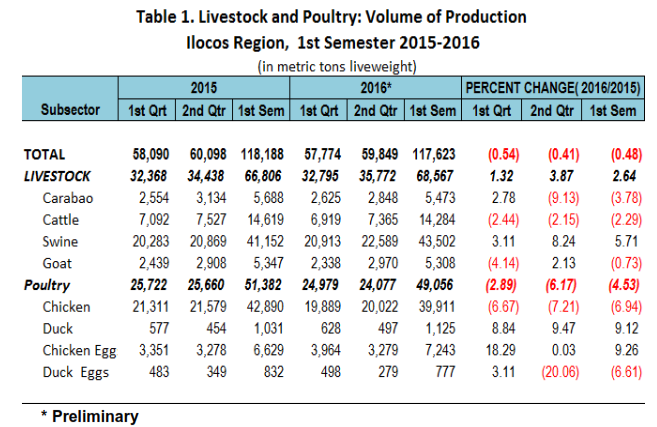
The major contributors to the total livestock and poultry production were swine and chicken with shares of 36.98 percent and 33.93 percent, respectively. Cattle followed with a share of 12.14 percent, chicken eggs with 6.16 percent, carabao with 4.65 percent, goat by 4.51 percent, duck and duck eggs with shares of 0.96 percent and 0.66 percent, respectively.
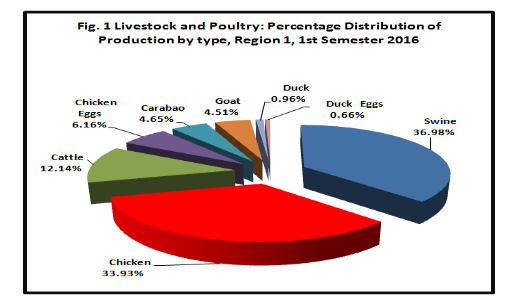
Livestock Sector
The region’s production on carabao was 5,473 metric tons live weight in 1st semester 2016. This decreased by 3.78 as compared to 1st semester 2015 level. Region I contributed 7.78 percent to the national production of 70,371 metric tons and ranked 5th among the top carabao producing regions.
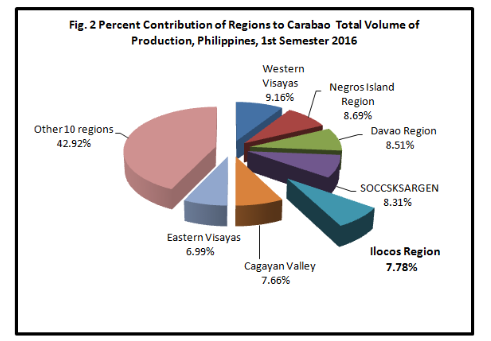
Total carabao inventory as of January 1, 2016 was estimated at 163,571 heads. It was 2.03 percent higher than last year’s headcount as more stocks were reserved for breeding purposes. Backyard farms accounted 99.75 percent of the total carabao population while the remaining 0.25 percent were accounted in commercial farms.
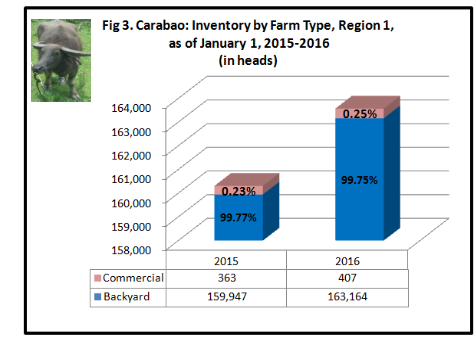
Production of cattle in Region I was estimated at 14,284 metric tons liveweight or 2.29 percent lower than last year’s level. Region I ranked 3rd in the country’s cattle production of 131,369 metric tons with a share of 10.87 percent.
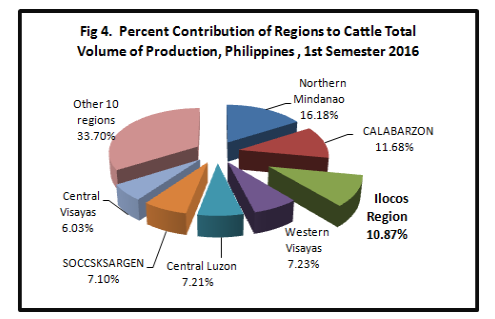
The total inventory of cattle as of January 1, 2016 was 301,578 heads. This showed an increase of 1.29 percent as compared to the same period last year as more were kept as breeders in backyard farms. About 99.16 percent of the total inventory were in the backyard, while the remaining 0.84 percent were in the commercial farms
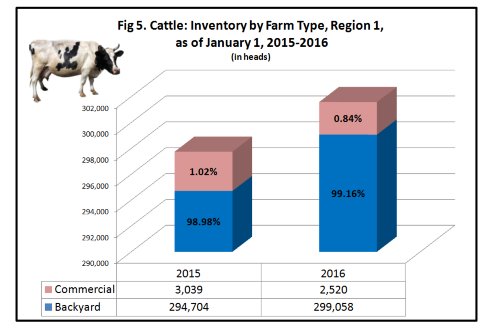
Swine production in Region 1 gained by 5.71 percent this 1st semester 2016 over last year’s level of 41,152 metric tons. The total production in the country is1,076,528 metric tons liveweight. Region 1 is ranked nine among the top producers. with a share of 4.04 percent.
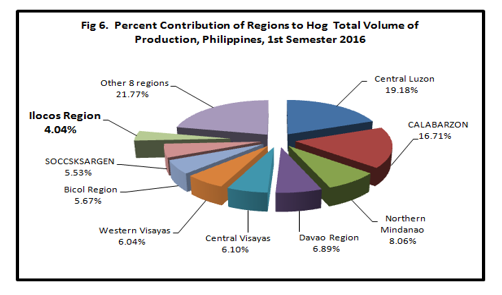
Total inventory of swine as of January 1, 2016 was 555,397 heads, higher by 6.47 percent than last year. Out of this total inventory, 81.70 percent were in backyard farms, while 18.30 percent were in commercial farms. The number of swine on both backyard and commercial farms grew by 6.20 percent and 7.73 percent, respectively.
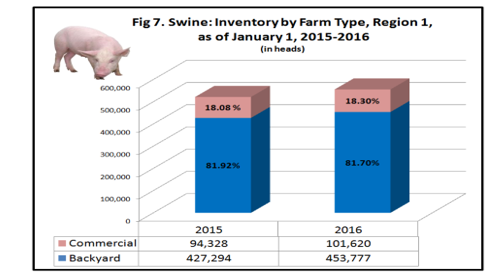
Goat production was estimated at 5,308 metric tons equivalent to a drop of 0.73 percent as compared last year. Region 1 remained as the number one producer of goat in the country with a share of 14.12 percent to the national production of 37,601 metric tons.

Total population of goat in the region as of January 1, 2016 was 406,321 heads. This was lower by 4.13 percent over last year’s headcount. About 98.56 percent of the total goat inventory were in backyard farms while the remaining 1.44 percent were in the commercial farms.
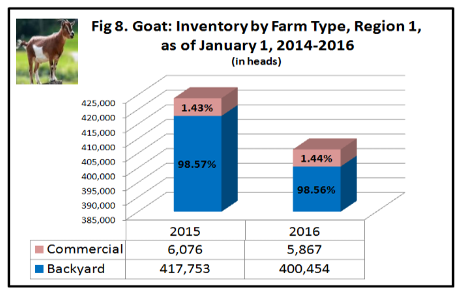
Poultry Sector
Production of chicken in the region for the 1st semester of 2016 was 39,911 metric tons. This was down by 6.94 percent as compared to same period last year. The contraction on the region’s chicken production was attributed to Newcastle Disease. This avian disease spread throughout the region and caused high mortality on native chickens and free range chickens.
Region 1 was among the top five producers of chicken in the country during the first half of 2016 with a share 4.88 percent.
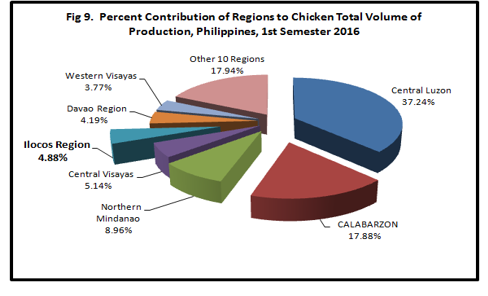
It is shown in figure 10, the beginning inventory of native chicken as of January 1, 2016 grew by 2.24 percent as compared to same date last year. However, inventory as of April 1, 2016 dropped to 5,015,948 heads or about 15.58 percent lower than last year of same date and 16.84 percent if compared to January 1, 2016 which can be attributed to Newcastle Disease.
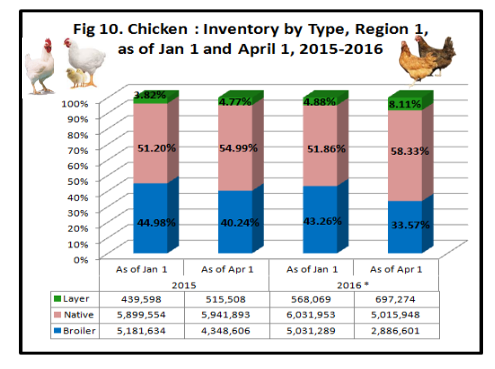
Likewise, inventory of broiler as of April 1, 2016 decreased by 33.62 percent as compared to same date last year and by 42.63 percent as compared to January 1, 2016. The share of broiler to the total chicken inventory was 43.26 percent as of January 1, 2016 and 33.57 percent as of April 1, 2016.
The population of layers as of January 1, 2016 increased by 29.22 percent as compared to same date last year and its share to the total inventory also increased from 3.82 percent to 4.88 percent. It was noted that there were expansion of layer farms in the region especially in Ilocos Norte and Ilocos Sur. This contributed to the 9.26 percent gain on production of chicken eggs during the semester.
Duck production for the first half of 2016 was 1,125 metric tons. This grew by 9.12 percent as compared to same period last year. Region 1 contributed 5.79 percent of the country’s total duck output of 16,057 metric tons.
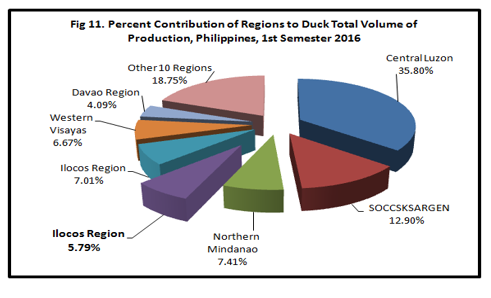
The backyard inventory of duck as of January 1, 2016 was 369,179 heads. This increased by 3.09 percent as compared to same period last year. Likewise, the inventory of duck in commercial farms increased by 0.55 percent as compared to last year’s level. About 93.01 percent of the total duck inventory were in the backyard farms, while the remaining 6.99 percent were in the commercial farms.
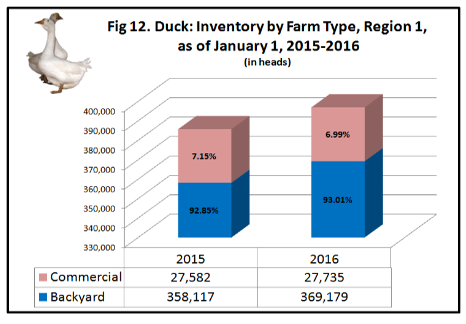
TECHNICAL NOTES
· Newcastle Disease. Newcastle Disease is one of the most serious of all avian diseases. It is caused by a virus (paramyxovirus, of the Group 1 serotype). The incubation period (time from exposure to the development of signs of disease) is 4 to 7 days. In general, signs can include ocular and/or nasal discharge, dyspnea, and bloody diarrhea. Central nervous system signs can also occur, including depression or the opposite-hyperexcitability; vestibular or balance problems; tremors, especially of the head and neck; weakness; and partial or total paralysis. The onset of signs may be semi-acute to sudden death. Signs vary depending on the strain of virus and the species of bird. (www.peteducation.com)
· Production. Refers to the volume of indigenous (locally-raised) animals disposed for slaughter which include animals exported or shipped-out for slaughter (in “head” and in “liveweigh equivalent”).
· Livestock – farm animals kept or raised for consumption, work or leisure. In general, poultry is separated as a distinct group of farm animals. For purposes of census and surveys, livestock covers only those that are tended and raised by an operator.
· Poultry - a collective term for all domesticated avian for the purpose of food consumption or, the carcass of such avian dressed/processed for human consumption.
· Animal Inventory (also, Animal Population) – the number of domesticated animals in head present in the farm at specific reference date.
· Backyard Farm/Raiser- refers to any farm or household raising at least one head of animal or bird and does not qualify as a commercial farm.
· Commercial Livestock Farm/Operator - refers to any livestock operator or farm which operation satisfies at least one of the following conditions: a) at least 21 head of adults and zero young b) at least 41 head of young animals c) at least 10 head of adults and 22 head of young animals.
· Commercial Poultry Farm/Operator- refers to any poultry operator or farm which operation satisfies at least one of the following conditions: a) 500 layers or 1,000 broilers b) 100 layers and 100 broilers if raised in combination c) 100 head of duck regardless of age.

